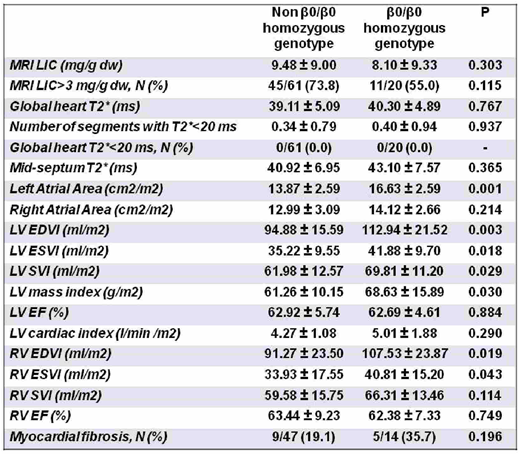Abstract
Background: In non transfusion dependent thalassemia (NTDT) the lack of a clear genotype-phenotype relationship complicates the already complex and extensive scenario in clinical practice. Our aim was to detect if the presence of a β°/β° homozygous genotype is associated to increased iron overload and rate of complications.
Methods: We considered 81 patients with thalassemia intermedia never transfused o who received occasional transfusions (37.7±11.4 years, 39 females) enrolled in the Myocardial Iron Overload in Thalassemia (MIOT) project. Magnetic Resonance Imaging (MRI) was used to quantify iron overload (T2* technique), biventricular morphological and functional parameters (cine sequences), and the presence of myocardial fibrosis (late gadolinium enhancement-LGE technique). All complications were classified according to international guidelines.
Results: Two groups of patients were identified: non homozygous β°/ β° genotype (N=61) and homozygous β°/ β° genotype (N=20.) No significant differences for sex and age were found between the groups.
The frequency of non chelated patients was significantly lower in the homozygous β°/β° group (17.6% vs 49.1%; P=0.026) and the frequency of desferrioxamine therapy was 70.6 in the homozygous β°/β° group and 43.4 in the non homozygous β°/β° group (P=0.051).
Patients with homozygous β°/β° genotype had lower mean haemoglobin levels (8.6±1.1g/dl vs 9.2±1.2 g/dl) but the difference did not reach the statistical significance (P=0.060).
Serum ferritin levels, liver transaminases and MRI liver iron concentarion (LIC) values were comparable between the groups.
No patient showed cardiac iron and global heart T2* values were comparable between the two groups.
Left atrial area index, left ventricular (LV) end-diastolic, end-systolic and stroke volume indexes, LV mass index, right ventricular end-diastolic and end-systolic volume indexes were significantly higher in the homozygous β°/β° group (see Table).
Frequencies of heart failure and arrhythmias were comparable between the groups.
No patient showed diabetes or hypoparathyroidism and there was no difference between groups in terms of frequency of hypogonadism or hypothyroidism. Conversely, patients with homozygous β°/β° genotype had a significant higher frequency of osteoporosis (50.0% vs 16.7%; P=0.003). Among patients with osteoporosis, 75% were treated with DFO therapy.
Conclusions: Heart remodelling related to a high cardiac output state cardiomyopathy was more pronounced in patients with homozygous β°/β° genotype. Osteoporososis was significantly more frequent in patients with homozygous β°/β° genotype, treated for more than two-thirds with DFO therapy. These data support the knowledge of different phenotypic groups in the management of NTDT patients.
Pepe:Chiesi Farmaceutici S.p.A., ApoPharma Inc., and Bayer: Other: No profit support.
Author notes
Asterisk with author names denotes non-ASH members.


This feature is available to Subscribers Only
Sign In or Create an Account Close Modal